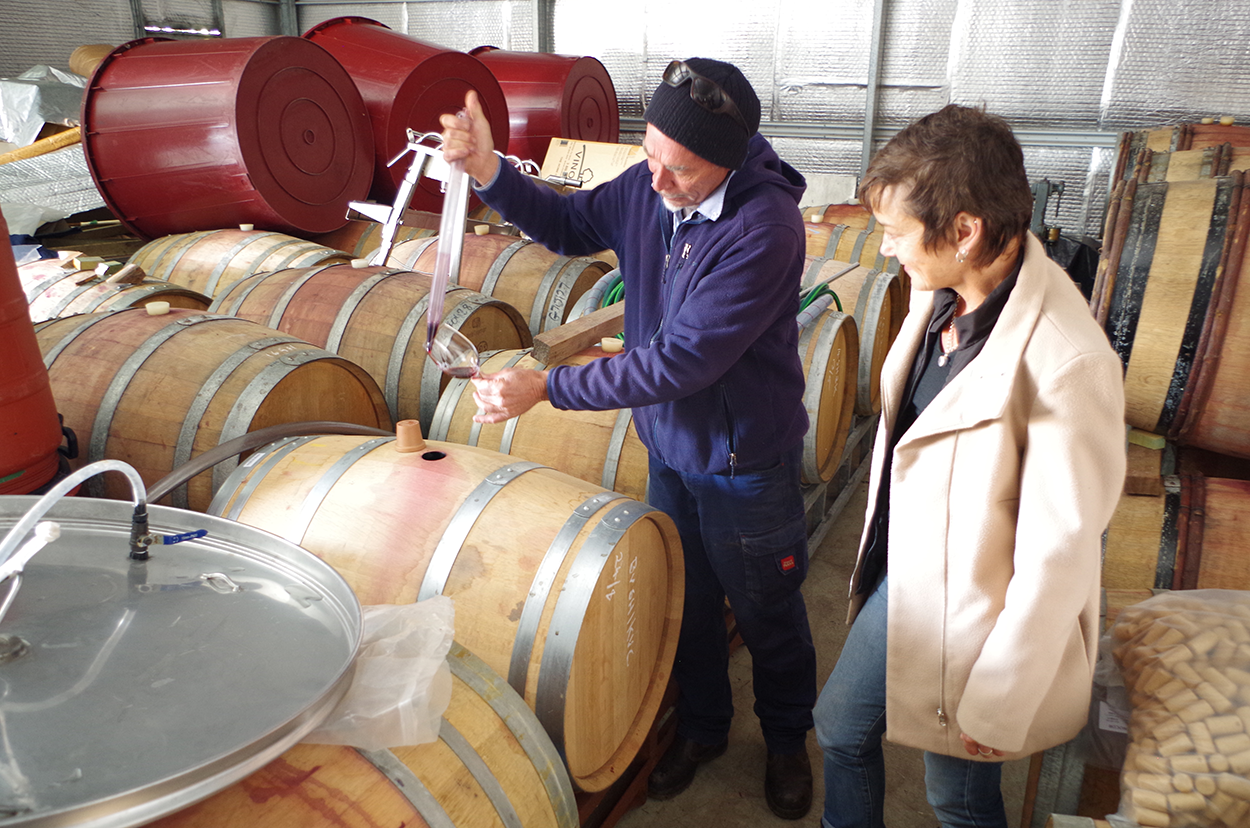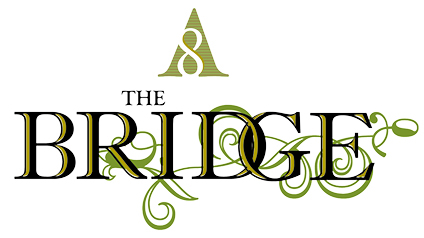All our wines are produced with a view to their structure for extended ageing and balanced with enjoyment and complexity at the dining table. They are best enjoyed with anyone anywhere anytime
The BRIDGE Vineyard is a small wine-growing property five kilometers North of Heathcote township. Surrounded by millionaires and coveted by many more, the vineyard has begun to produce some of the most specific single vineyard wines in Australia today.
The BRIDGE Vineyard was the catalyst for a separate range of wines called Knots made from grapes sourced from the neighboring Central Victorian Bendigo Wine Region. Grapes for Knots range of superb wines are only sourced from old vine vineyards and superior vineyard sites. Careful selection of grapes allows wine maker Lindsay Ross to create a range of wines that display the exceptional qualities of the Bendigo region’s influence on each variety and seasonal characteristics.
“There aren’t many pink wines produced in Bendigo, but the 2001 Knots Rose Lashing Rose ($20), with its full-bodied rosehip flavour and dry finish, could inspire more producers to have a bash. Knots is the new label from ex-Balgownie winemaker Lindsay Ross, who makes it using fruit sourced from various vineyards around the region. The rose is the best wine in the line-up so far,in my opinion, closely followed by a chewy shiraz and pulpy semillon sauvignon blend.”
Max Allen – The Weekend Australian
Visiting The BRIDGE Vineyard is like an adventurer discovering a hidden valley. Shurans Lane is 5 Km North of Heathcote township only 200 meters long it turns left into Bridge Way, our drive, that drops to the valley floor and the stone bridge that accesses the vineyard. Ascend the valley slopes to our cellar door and magnificent views of this pretty little valley.


History – first plantings were in 1998 with Shiraz and Malbec.
The vineyard site was chosen due to its potential and superior site conditions for creating super premium red wines notably Shiraz.
The vineyards advantages enable the property to be operated as a natural entity employing techniques from traditional, organic and bio-dynamic schools of agriculture.
The superior aspects of the vineyard include:
- East facing slope
- Deep Cambrian soils
- Elevation
- Frost free
- Valley breezes
- Soil minerals
The deep Cambrian soils present a myriad range of minerals that impact on the color flavor and structure of the wines from the vineyard include no irrigation, no synthetic fertilizers ,no herbicides and low cropping levels provides a wine that did not need acid adjustment, enzymes, tannins, fining agents or unnecessary modifications. Its only natural.
Cropping at ¼ ton per acre is economic madness but it is at these levels that the vines are able to ripen their grapes and produce the concentration desired. This is a pre-requisite for full site expression in single vineyard wines.
The philosophy has been created out of 30 years of industry experience and the potential of producing wines that are individual and true.
Winemaker – Lindsay Ross
Lindsay Ross was born near New Zealand’s famous wine growing region of Henderson / Auckland. This proximity encouraged him to seek a career in the wine industry, a career that has lead him across the world from New Zealand to Europe and later Australia.
A big statement, which is not made, idly! But in the knowledge that the experience he gained in all disciplines of viticulture, wine making and wine marketing over the years cannot be gained in a classroom.he journey has provided experiences in the wine industry at a level surpassing the highest education levels achieved in any of the wine courses available in Australia today.
Lindsay began his pilgrimage to Central Victoria at Montana Wines in New Zealand which was then the most progressive wine business in New Zealand.
The travel bug then took him to Europe for an extended stay in Germany working on the 1979 vintage and post vintage bottling with Heinrich Kblor a reputable winemaker in the Rheinphaiz.
Lindsay returned to the Southern Hemisphere armed with his new found European winemaking skills and immediately took part in the 1980 Rothbury Estate vintage. A winery founded through the vision of Len Evans.
Rothbury Estate gave Lindsay an opportunity to appreciate the corporate style of a modern Australian winery.
Further travels lead him eventually to Balgownie Estate, a highly regarded family owned winery that allowed him to be involved with the total business and its development under the stewardship of Stewart Anderson a pioneer of the resurging Victorian wine industry.
During this phase Lindsay undertook academic studies with Charles Sturt University earning a diploma in Viticulture in 1985.
The Balgownie vineyard was purchased in the mid-eighties by Mildara Wines. This gave Lindsay the opportunity to be associated with the restructuring and growth of a major wine company at a managerial level.
Achieving a career path at Balgownie Estate that lead from the vineyard to chief winemaker has been a satisfying consolidation of Lindsay’s wine making philosophy which has lead to an enviable list of award winning wines.
Applying his knowledge of what he believed constituted a successful quality wine business Lindsay began an extensive search for a suitable property of his own.
The search included possibilities in both Australia and New Zealand before he found a perfect block of land in Heathcote, just 70 Kilometers south of Bendigo.
So was born `The Bridge Vineyard’ – a venture Lindsay sees as the culmination of his winemaking career where he can showcase his winemaking philosophy and create a unique, `natural’ vineyard using a minimum of intervention.
The Bridge Vineyard cellar door is expected to open soon where visitors can acquire a `good bottle’ and have a chance to kick back with Lindsay and his partner Noeline and on one of those lazy weekend outings.

The Knots Project
History – Established in 2000
Created in a whirl and swirl of a long summer lunch. The Knots was a response to the proliferation of the predictable path that wine marketing had been taking. Knot the project was a view that the range of knots would be useful as monikers for wine styles and varieties, it would be lateral yet recognizable to all- but also intriguing.

The Bendigo region we knew well from my long stint at Balgownie. The region traditionally provides rich intensely spicy red wines and selecting vineyards from the Northern and Southern parts would enable full ripe flavors with elegance.
Vineyards were selected on their potential to provide quality fruit of substance and concentration with fruit from some of the oldest vineyards (30+ years) in Bendigo being used in the Shiraz and Cabernet Merlot styles.
Knots are an expansive range of wine styles with a hallmark note of flavor and roundness. Other wines in the range include a dry Rosé made from Cabernet mainly, but will include bits and pieces of what ever variety is available, a Chardonnay made in a low oak partial malo-lactic natural acid style or the Semillon Sauvignon Blanc a full rich oak ferment style. Occasionally a 100% Cabernet Sauvignon is made and only if the quality justifies.
Summary
- Established 2000
- First Release 2001
- Export Destinations : Belgium Switzerland
- Wine Shows РBronze medals ; Rose Lashing Ros̩ & Sheep Shank Shiraz
Snapshot of Vintages
- Vintage 2004 – The even years and settled weather. A season which put the pressure on but the crops were excellent. Another classic
- Vintage 2003 – A 1 in 100 year drought had ravaged the land, the grapes came through with some BIG wines
- Vintage 2002 – An exceptional year with fruit ripeness and strong vines providing bright colors and flavors.
- Vintage 2001 – Mild dry conditions with an Indian summer that ran to May. Soft fruit flavors and fully mature crops.
Harvest and Winemaking
Producing the Knots as Bendigo region wines from our passionate growers, old vines and exceptional vineyard sites the 2004 vintage red wine release is from a classic year
Harvesting is in part complicated (distance ) and simplified (different sites ripen differently) for the Knots range. Decisions on harvest are dictated by what the season has been like and the potential of each vineyard. The up shot of this is the opportunity to pick grapes at the best advantage to the whole blend or the style.
The winemaking harvest procedures following similar trends to the BRIDGE although the wines are more in the modern style of wine making. Flavor is paramount on when to pick and then as much during the process with bottling after 15 months of oak maturation for reds 12 months for whites.
